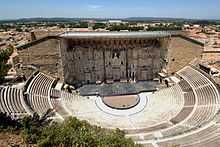Théâtre antique d'Orange
| Roman Theatre and its Surroundings and the Triumphal Arch of Orange | |
|---|---|
| Name as inscribed on the World Heritage List | |
 | |
| Type | Cultural |
| Criteria | iii, vi |
| Reference | 163 |
| UNESCO region | Europe and North America |
| Inscription history | |
| Inscription | 1981 (5th Session) |
The Théâtre antique d'Orange ("Ancient Theatre of Orange") is an ancient Roman theatre, in Orange, southern France, built early in the 1st century AD. It is owned by the municipality of Orange and is the home of the summer opera festival, the Chorégies d'Orange.
It is one of the best preserved of all the Roman theatres in the Roman colony of Arausio (or, more specifically, Colonia Julia Firma Secundanorum Arausio: "the Julian colony of Arausio established by the soldiers of the second legion") which was founded in 40 BC. Playing a major role in the life of the citizens, who spent a large part of their free time there, the theatre was seen by the Roman authorities not only as a means of spreading Roman culture to the colonies, but also as a way of distracting them from all political activities.
Mime, pantomime, poetry readings and the "attelana" (a kind of farce rather like the commedia dell'arte) was the dominant form of entertainment, much of which lasted all day. For the common people, who were fond of spectacular effects, magnificent stage sets became very important, as was the use of stage machinery. The entertainment offered was open to all and free of charge.
As the Western Roman Empire declined during the 4th century, by which time Christianity had become the official religion, the theatre was closed by official edict in AD 391 since the Church opposed what it regarded as uncivilized spectacles. After that, the theatre was abandoned completely. It was sacked and pillaged by the "barbarians" and was used as a defensive post in the Middle Ages. During the 16th-century religious wars, it became a refuge for the townspeople.

The "Roman Festival" and the Chorégies
During the 19th century the theatre slowly began to recover its original splendour, due to the efforts of Prosper Mérimée, who then held the position of director of "Monuments Historiques". Under his direction, restoration work began in 1825 and in 1869 the theatre became the home of a "Roman Festival" which celebrated the glory of Rome and included a performance of Méhul's opera, Joseph. In the latter part of the century, all the major players of the French classical stage appeared in the Orange festivals, including Sarah Bernhardt who played "Phèdre" in 1903.
By the end of the century, the tiered seats were restored, a reflection of the bureaucratic process. In 1902 the festival was given a new name, the "Chorégies," planned as an annual summer festival. The name comes from the tax that was imposed on wealthy Romans to pay for theatrical productions. Until 1969 the Chorégies consisted of plays, alternating with musical works, opera and symphonies. However, after that date, Orange became solely an opera festival and theatrical works were performed at Avignon.
In 1981 UNESCO declared the theatre as a World Heritage Site.
Gallery
-

Seating in the theatre -

A performance as part of the Chorégies festival -
The centaur frieze -

The new stage roof -

Roman Theatre with new stage roof -

The French Foreign Legion celebrating Camerone Day in the Roman Theatre of Orange
See also
External references
| Wikimedia Commons has media related to Roman Theatre of Orange. |
